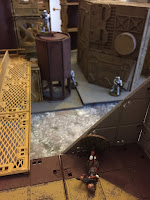The core of the Swedish army of the Napoleonic Wars was a standing army that during peace time saw only limited time of drill and other actual time serving in the army. These are the alloted (indelta) units. What they lacked in training were to some extent made up with experience as many had served for 10+ years and loyalty to the unit as they served together with men from their own neighbourhood. The rest of the army was made up from enlisted (värvade) units. During the war there were also some militia being used from the vargering and the lantvärn. For a more in-depth look you might want to read this article by Magnus Olofsson.
 |
| Regimental Jaegers of the Upland Regiment (note the black belts and green plume denoting their jaeger capacity). Picture from the Anno 1808 - Uplands Regemente re-enactment group, please see more of them HERE |
The Battalion and the use of Jaegers
The battalion, usually some 500-600 men strong, was the basic tactical infantry unit in the Swedish army. Most battalions had four companies with two platoons per company. Some of the enlisted units were organized differently. From 1806 the infantry was to be deployed in two ranks but this was supposedly changed back to three ranks in 1813.
For skirmishing action the Swedish army had some, often enlisted, units of "pure" jaeger like the Wermlands Fältjägare. However, from 1805, what was more prominent was the use of Line Infantry Jaegers or regementsjägare ("regimental jaeger"). The term regimental jaeger is a bit confusing as they were formed from their parent battalions but as mentioned below they were sometimes merged into bigger units and used at a higher organisational level.
 |
| Perry Miniatures Wermland Jaegers (SWED 12), an enlisted unit. |
The introduction of regimental jaegers followed Sweden’s war against Russia 1788-1790. The efficiency of light troops in broken terrain resulted in an increased Swedish focus on light infantry action. Not only were all line infantry to be trained in fighting in dispersed order but also every Swedish battalion was to have a platoon of jaegers selected from suitable men of the battalion. Originally, each infantry battalion was to form a 53 men strong jaeger platoon (one officer, two NCO’s, two corporals and 48 privates) but in 1806 this was doubled to a 106 men strong jaeger company per battalion. In the 1813, the number of jaeger per battalion was again lowered to 58 officers and men (one officer, two NCO’s, four corporals, one bugler and 50 privates).
The employment of these Line Infantry Regimental Jaegers varied; sometimes they were used as skirmishers for their parent battalion, sometimes merged to a regimental jaeger company or battalion, but most often they were removed from their parent battalions and formed into a light infantry battalion held at brigade level.
The Regimental Jaeger Uniform
As noted above the Swedish Line Infantry Jaegers ("regementsjägare") wore the same uniform as their parent unit. However, their leather belts were often black instead of white and they wore a green plume. Jaegers of non Line Infantry units often had a similar change compared to their parent regiment uniform aswell.
Earlier posts on Swedish Soldiers of the Napoleonic Wars
Part I - Swedish Soldiers of the Napoleonic Wars - an Overview
Part II - Swedish Soldiers of the Napoleonic Wars - a Modeling Tutorial for 1806-1809
Part III - Swedish Soldiers of the Napoleonic Wars - Uniform Colours and a Painted Example
Part IV - The Swedish Soldier's Greatcoat - a Tutorial















